Best Yoga Poses : Yoga is well-known for making the back feel better and keeping the spine healthy. It uses certain poses to both strengthen and stretch the back-supporting muscles. This leads to improved posture, more flexibility, and less pain.
The Cat-Cow pose soothes, while the Downward-Facing Dog energizes. Both types of poses help in a complete way to deal with back pain and bring the body back into balance.
Key Takeaways
- Yoga poses like Cat-Cow, Downward-Facing Dog, and Extended Triangle can help strengthen and relax back muscles
- Practicing yoga for even a few minutes a day can increase body awareness and promote better alignment
- Yoga is often recommended as a natural remedy for back pain and the associated stress
- Incorporating these yoga poses into a regular routine can provide long-term relief and improved back health
- Consistent practice of these back-friendly yoga poses can lead to better posture and overall spinal well-being
Introduction to Yoga for Back Pain Relief
Yoga helps both the mind and body fight back pain. It uses special poses and techniques. These can ease back pain and boost your health.
Benefits of Practicing Yoga for Back Health
Starting yoga can do wonders for your back. It makes your spine more flexible and your muscles stronger. This gives your spine better support. Yoga also helps you become more aware of your body. This can show you where you have tension or imbalance.
Yoga lowers your stress. This is important because stress can make back pain worse. It helps you stand and sit straighter. And it boosts blood flow, which speeds up healing.
By adding yoga to your routine, you can effectively deal with back pain. It improves your spine’s health. This enhances your life overall.
“Yoga is an ancient art based on a harmonizing system of development for the body, mind, and spirit. The continued practice of yoga leads to peace. It makes you feel at one with the world around you.”
Yoga is more than exercise. It’s part of a plan to manage back pain. Understanding its benefits can make your life better. It can bring lasting relief and better spinal health.
Also Read : The Top 9 American Universities You Should Consider Studying In
Cat-Cow Pose
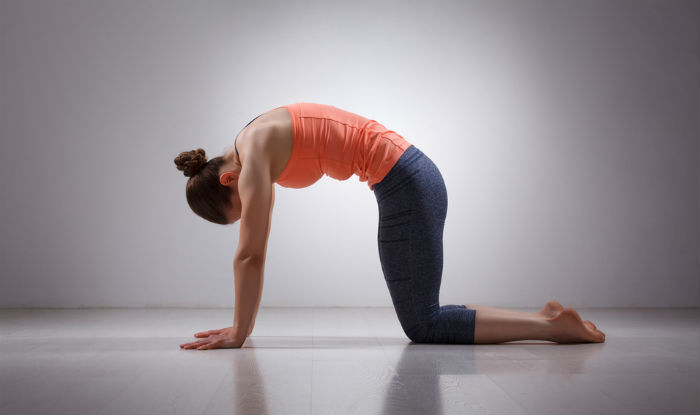
The cat-cow yoga pose is great for your back. It stretches and moves your spine gently. It’s perfect for yoga lovers, helping with back health and feeling good. Let’s dive into how to do the cat-cow pose right and the main muscles it helps.
How to Perform Cat-Cow Pose
Start on all fours. Make sure your hands are under your shoulders and your knees under your hips. Take a deep breath. Arch your back up, lifting your tailbone and chest like a cow, as you breathe in.
As you breathe out, round your back. Tuck your chin and tailbone under, like a cat stretching. Do this in a smooth motion, following your breath. Move from the cow to cat pose with each inhale and exhale.
The cat-cow pose works your erector spinae along your spine and your ab muscles, including the rectus abdominis. It also engages arm muscles like the triceps and chest muscles like the serratus anterior. Even your big butt muscle, the gluteus maximus, gets a workout. This pose makes your back stronger and more flexible.
If you want to ease back pain, fix your posture, or just take care of your spine, try the cat-cow pose. It’s a calming move that welcomes you to your yoga mat. Add it to your routine and see how good it makes you feel.
Also Read : 3 Things You Should Know About Health Insurance: Ultimate Guide
Downward-Facing Dog
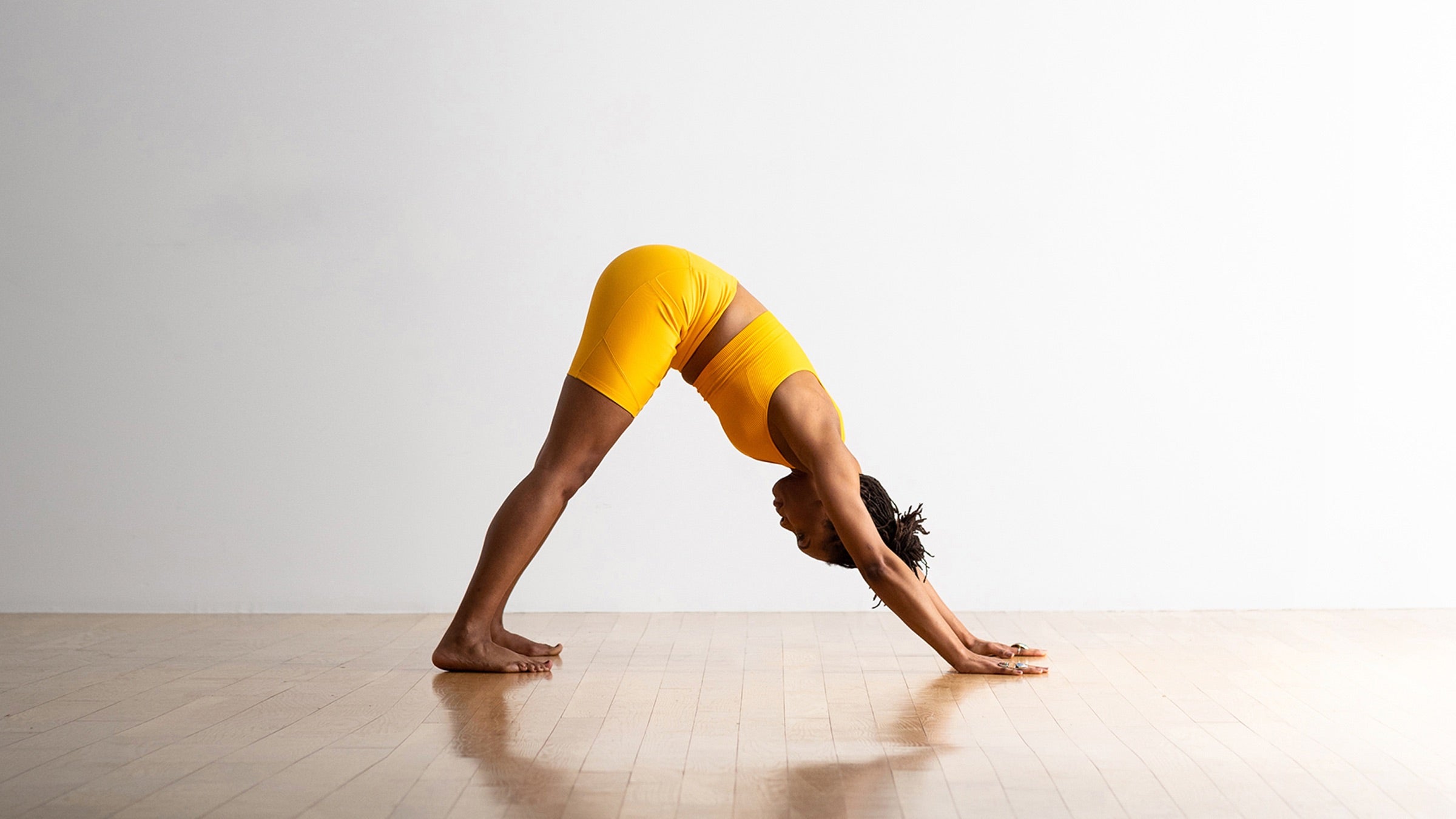
The downward-facing dog pose is called Adho Mukha Svanasana in yoga. It’s a forward bend that not only relaxes but also energizes you. This pose is very common in yoga and helps with many health benefits, like reducing back pain and sciatica.
This yoga pose is great for body balance, making you stronger and more flexible. It also helps calm your mind. In this pose, your hamstrings, deltoids, gluteus maximus, triceps, and quadriceps work a lot. So, it’s a good exercise for your whole body.
How to Do Downward-Facing Dog
- Start on all fours, with your hands shoulder-width apart and your knees hip-width apart.
- Tuck your toes under and push into your hands to lift your hips up and back. Your body should look like an upside down “V”.
- Keep your knees slightly bent and balance your weight on your hands and feet.
- Use your core muscles to help your back stay straight. Keep your neck in line with your spine.
- Take deep breaths. Let your shoulder blades move down and away from your ears. Push your heels towards the floor.
“Downward-facing dog is a foundational yoga pose that helps to release tension in the back and shoulders while also strengthening the entire body.”
By doing the downward-facing dog pose regularly in yoga, you get a stronger back. It also boosts your overall health and peace of mind.
Also Read : What You Need to Know About Getting A Home Loan
| Muscles Worked | Benefits |
|---|---|
| Hamstrings | Stretches and lengthens the hamstring muscles |
| Deltoids | Strengthens the shoulder muscles |
| Gluteus Maximus | Engages the glute muscles |
| Triceps | Strengthens the triceps muscles |
| Quadriceps | Strengthens the quadriceps muscles |
Extended Triangle Pose
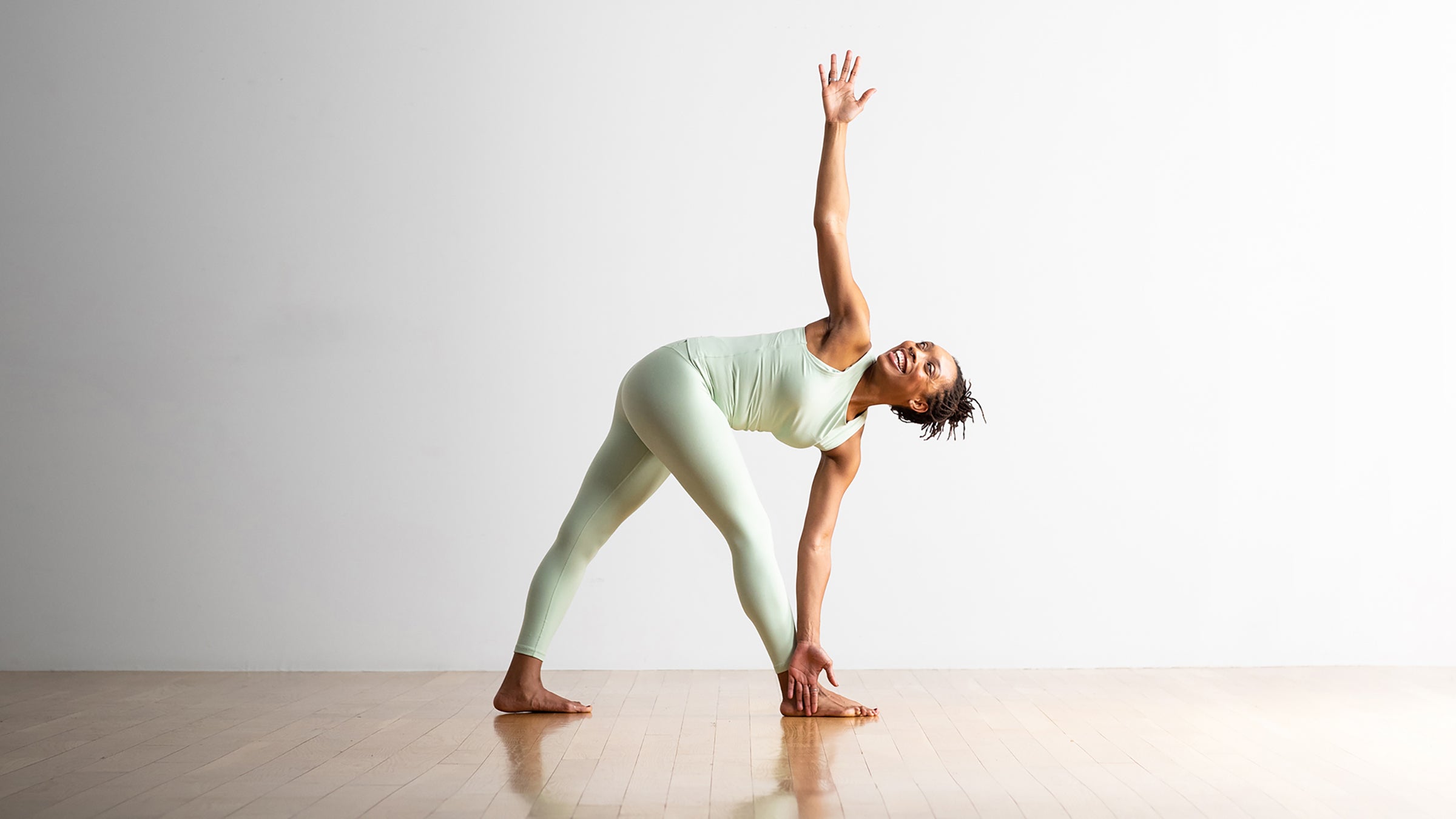
The extended triangle pose, or Utthita Trikonasana, helps ease back pain, sciatica, and neck tension. It stretches the spine, hips, and groin. It also builds strength in the shoulders, chest, and legs. Regular practice might reduce stress and anxiety too.
Steps to Practice the Extended Triangle Pose
- Start by standing with feet 4 feet apart. Right toes face forward, left toes point out.
- Raise both arms straight out to the sides.
- As you breathe out, bend at the right hip, lowering your torso right. Place your right hand on your leg or the floor.
- Point your left arm toward the sky. Keep your shoulders over each other. Look up at your left hand.
- Stay in the pose for 5-10 breaths. Then, switch to the other side.
This pose mainly works on the latissimus dorsi, internal oblique, and more. It helps the spine stay strong, betters your posture, and boosts your back and core muscles.
“The extended triangle pose is a wonderful way to lengthen the spine, open the hips, and create balance and stability throughout the body.”
Are you after a better back and more strength? Or maybe just increased flexibility? The extended triangle pose is perfect for that. Learn the right way to do it, and feel its many advantages in your yoga sessions.
Also Read : The 5 Worst Mistakes That You Make When Selecting Health Insurance
Sphinx Pose
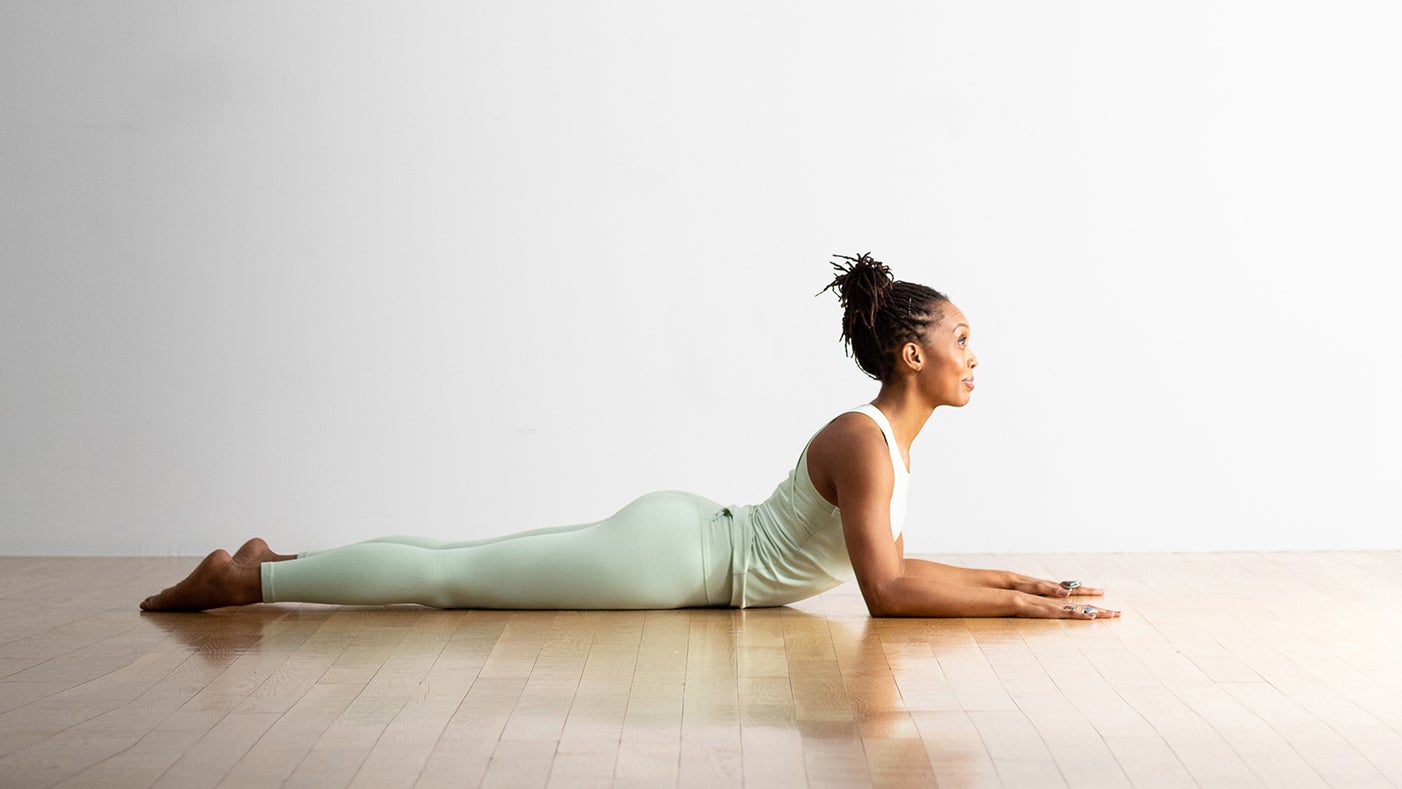
The sphinx pose is a well-known yoga backbend. It’s great for keeping your back healthy. It makes your spine, backside, and core stronger. Also, it stretches your chest, shoulders, and tummy. Doing this pose is good for beating stress and feeling calm. So, it’s perfect for any yoga practice.
First, lie on your tummy. Put your legs straight back and your palms on the floor by your shoulders. Your elbows should be close to your body. Use your back, buttocks, and thighs to lift your chest and head gently. Keep your eyes forward.
Breathe deeply while you hold this pose. Then, slowly lower back down.
Key Muscles Worked in Sphinx Pose
- Erector spinae: These muscles along the spine help keep your back up and steady.
- Gluteal muscles: Your glutes keep your hips and lower body stable.
- Pectoralis major: The big chest muscle gets a good stretch.
- Trapezius: Your upper back and shoulder muscles work to keep you balanced.
- Latissimus dorsi: The “lats” support your spine during this pose.
This pose targets many important muscles. It means better posture, less back pain, and a healthier spine. If you want to add gentle backbends to your yoga, or if you need to relax, try the sphinx pose. It’s a valuable move for your yoga routine.
“The sphinx pose is a great first step for deeper backbends. It opens up your front body and eases back tension. Plus, it’s good for making your spine stronger and more flexible.”
Also Read : The Best Universities in America for Freelance Professionals
Cobra Pose
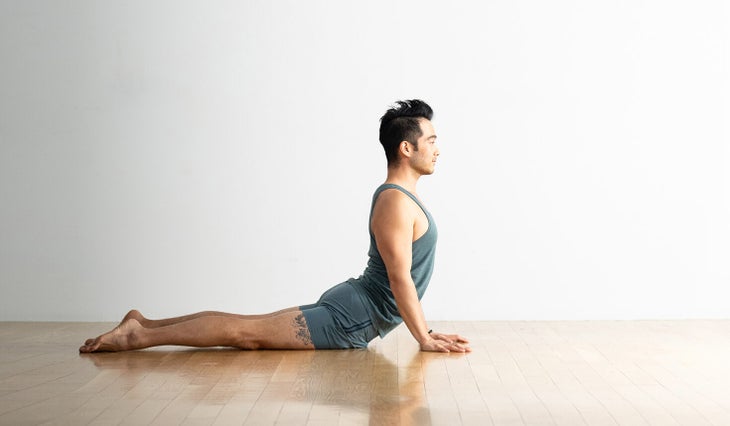
The cobra yoga pose is great for a gentle backbend stretch. It works your abdomen, chest, and shoulders. This pose strengthens your spine. Plus, it might help with sciatica, stress, and tiredness from back pain.
Technique for Low Cobra Pose and Benefits
Start the low cobra pose by lying on your stomach. Your forehead should touch the mat. Place your elbows under your shoulders with a slight elbow bend. On an inhale, lift your head, chest, and shoulders a bit. This creates a small backbend. Remember not to bend too far.
Low cobra works muscles like the hamstrings and triceps. It also hits the chest and shoulders. Doing this pose helps build up these muscles. It’s good for keeping your posture and spine straight. It also makes your chest and shoulders more flexible, enhancing movement.
“The cobra pose is a wonderful way to stretch and strengthen the back, while also promoting a sense of calm and relaxation.”
Focus on doing the low cobra with smooth movements and deep breaths. Don’t rush or overdo it. As you get better at it, the cobra pose can really help keep your back in shape without pain.
Locust Pose
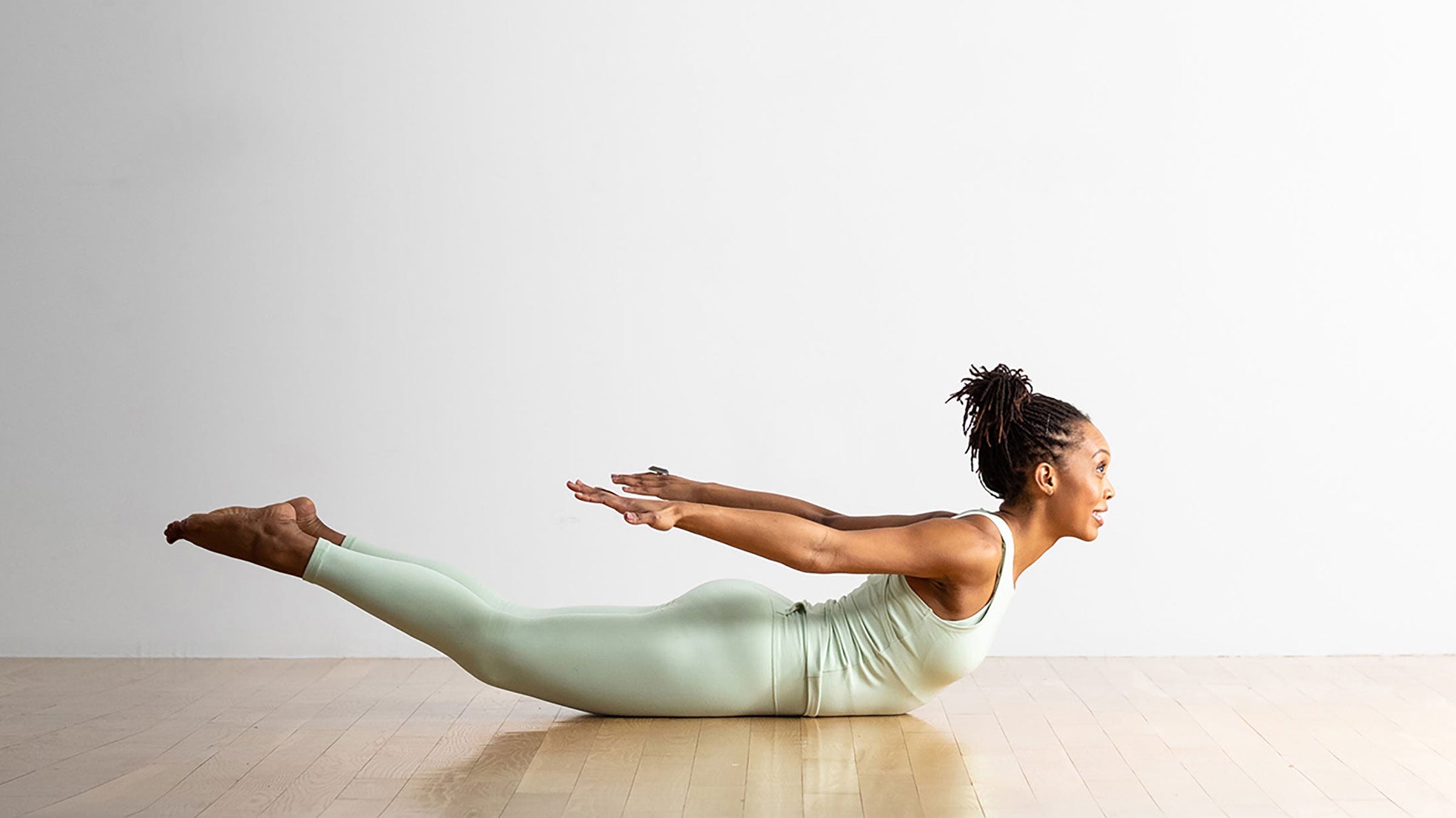
The locust yoga pose, also called Salabhasana, is great for your back. It helps with lower back pain and tired muscles. It makes your back, arms, and legs stronger, working key muscles.
Instructions for Locust Pose Variation
To do the locust pose, start lying on your tummy. Stretch your legs and let your forehead rest on the floor. Take a deep breath.
As you breathe out, lift your head, chest, and arms a bit. Keep looking forward. Then, if it feels okay, lift more. You can raise your chest and arms or go all the way up, depending on how you feel.
For a tougher version, lift your legs off the floor too. Use your core and bum muscles to stay up. Your shoulders should be relaxed, and don’t strain your neck. Take deep breaths and stay in the pose a while. Then, slowly lower back down.
“The locust pose is a wonderfully restorative backbend that can help alleviate back pain and fatigue. It’s a great pose to include in your yoga practice, especially if you spend a lot of time sitting or standing.”
Doing the locust pose brings many benefits of locust pose. It makes your posture better and your back strong. It also helps with spine flexibility. And you can change the pose to fit your own level, which is good for beginners and experts alike.
If you want to ease back pain, get stronger, or just relax with a nice stretch, try the how to do locust pose variation in your yoga. It’s a great move for many reasons.
Bridge Pose
:max_bytes(150000):strip_icc()/55-3567138-WheelPose-004-b768aa1db0ff4ba99e01947e2ffb5b84.jpg)
The bridge yoga pose is a true treasure. It helps stretch your spine and might ease backaches and headaches. It works out the core and lower body by using different muscles like the abs and glutes.
To start, lay on your back with knees up and feet flat. Keep them apart the width of your hips. Push into the floor with your arms and feet to lift your hips. Make a bridge shape with your body. Stay strong in your core and squeeze your butt. Hold this for about a minute. Then, lower your back down slowly to the ground, bit by bit.
- Lie on your back with knees bent and feet flat on the floor, hip-width apart.
- Press your arms and feet into the ground, lifting your hips off the mat.
- Engage your core and squeeze your glutes to maintain the bridge pose.
- Hold for up to 1 minute, then slowly lower your back down to the mat, vertebrae by vertebrae.
The benefits of the bridge pose are beyond count. It helps your posture and makes your spine more flexible. Plus, it eases tension in your neck and shoulders. This pose also makes your back, glutes, and legs stronger, giving you a stable core.
| Muscles Worked | Benefits |
|---|---|
| Rectus and Transverse Abdominis | Strengthens the core |
| Gluteus Muscles | Tones the buttocks |
| Erector Spinae | Improves posture and spine flexibility |
| Hamstrings | Stretches the back of the thighs |
If you want to lessen back pain or get stronger and more flexible, try the bridge yoga pose. Embrace the challenge. Let this backbend improve your body and soul.
Half Lord of the Fishes Pose
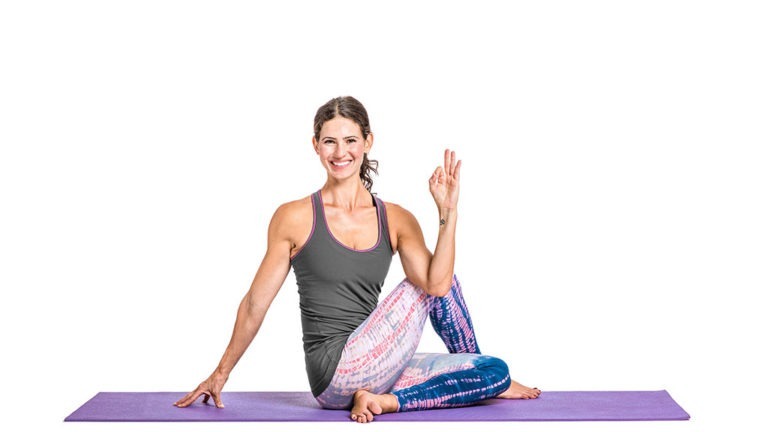
The half lord of the fishes pose, known as Ardha Matsyendrasana, is a strong yoga twist. It energizes the spine and relieves back pain. This pose also stretches the hips, shoulders, and neck. It helps internal organs too. Adding this twist to your yoga brings many health benefits. It helps keep your back healthy and improves your well-being.
How to Do the Half Lord of the Fishes Twist
To perform the half lord of the fishes pose:
- Sit on the floor with your right foot placed close to your body.
- Extend your left foot out to the side.
- As you twist your torso to the left, bring your right elbow to the outside of your left knee.
- Gaze over your left shoulder with a long, tall spine all the time.
- Keep the twist for several breaths then change sides and do it again.
The main muscles used in this pose are the rhomboids, serratus anterior, and more. These muscles work together to make your spine more flexible. They also reduce back tension and keep your back healthy overall.
“The half lord of the fishes pose is a wonderful way to stretch and twist the spine, providing a gentle release for the back muscles and a sense of renewed energy.”
If you’re aiming to ease chronic back pain or improve your spine health, include the half lord of the fishes pose in your yoga. Learning the right way to do it and practicing regularly has many benefits. You’ll enjoy a healthier, more flexible back.
Best Yoga Poses
Yoga poses can really change the game for back pain and spine health. For example, poses like cat-cow, downward-facing dog, extended triangle, cobra, and bridge are great for your back. They help stretch, strengthen, and relax your back muscles.
These effective yoga poses for back improve your spine’s movement and alignment. This lowers stress and tension in your back. Adding these top yoga asanas for spinal health to your day helps you become more flexible, have better posture, and enjoy a happier back.
| Yoga Pose | Benefits for Back Health |
|---|---|
| Cat-Cow Pose | Gently stretches and mobilizes the spine, promoting flexibility and improved posture. |
| Downward-Facing Dog | Strengthens the back and shoulder muscles, while also stretching the hamstrings and calves. |
| Extended Triangle Pose | Lengthens the side body, opens the hips, and can help alleviate lower back pain. |
| Cobra Pose | Backbend that strengthens the back muscles and improves spinal flexibility. |
| Bridge Pose | Targets the back, glutes, and hamstrings, helping to counteract the effects of sitting for long periods. |
Adding these best yoga poses for back pain to your routine can make your back healthier. But, it’s important to do them regularly. Remember to be patient. Your body needs time to get all the great results from these top yoga asanas for spinal health.
Two-Knee Spinal Twist
The two-knee spinal twist is a simple pose from restorative yoga. It can ease back pain and make your spine more flexible. This twist gently stretches your back, shoulders, and hips, helping you let go of stress. It’s perfect for anyone who wants a healthier back or just needs to relax.
Steps for Safe Spinal Twist Practice
- Lie on your back with knees bent, feet flat, hip-width apart.
- Reach your arms to the sides, palms on the floor, forming a “T” pose.
- Let your knees slowly move to one side, staying together, just above the floor.
- Look towards the opposite direction of the knees, gently turning your neck.
- Breathe deeply and hold this position for a while.
- Then, switch sides by letting your knees fall the other way.
The two-knee spinal twist is easy to do and brings many health benefits. It improves how flexible your spine is, relieves back pain, and supports good back health. When you add this pose to your yoga, you’ll feel the good it does for your spine.
“The two-knee spinal twist is a simple yet powerful pose that can help restore balance and flexibility to the spine.”
Child’s Pose
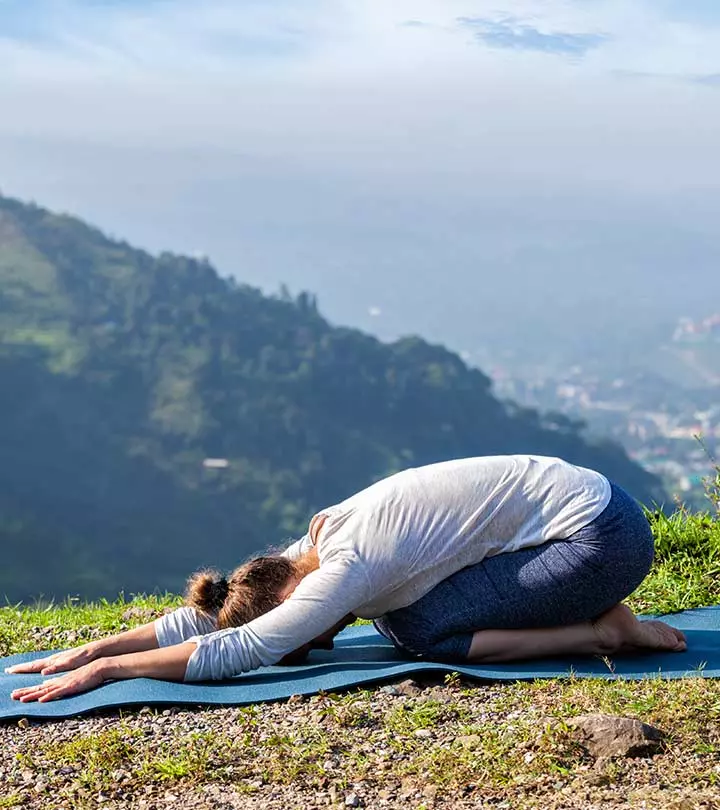
The child’s pose is a gentle yoga pose. It’s also called the balasana. It’s great for relaxing and letting go of neck and back tension. This pose stretches your spine and muscles in the hips, thighs, and ankles. It’s perfect for anyone who wants to take care of their back.
How to Do the Child’s Pose
Start the child’s pose by sitting on your heels. Spread your knees apart with toes touching. Then, fold your torso forward. Let your forehead rest on the floor or mat. Your upper body should rest over your thighs.
Feel your head and shoulders sink. Stretch your arms forward or let them rest at your sides. Finally, breathe deeply and stay in this pose as long as you like.
Benefits of the Child’s Pose
- Stretches and lengthens the spine, providing relief for back pain and tension
- Releases tension in the neck, shoulders, and upper back
- Calms the mind and promotes relaxation, making it a great pose to include in a restorative yoga practice
- Targets the gluteus maximus, rotator cuff muscles, hamstrings, and spinal extensors
The child’s pose is great for supporting your back health. It’s good for unwinding after a tough day. Also, it can help with chronic back pain. This simple pose is very effective for giving your body a break.
“The child’s pose is a profound resting posture that calms the mind, releases tension in the back, and renews the body.”
Also Read : 9 Essential Yoga Poses To Achieve Balance And Flexibility
Conclusion
Some of the best yoga poses for your back health are cat-cow, downward-facing dog, and more. They boost spine movement, release stress, and make your back muscles stronger. Doing these poses just a few times a day really helps keep your back happy and healthy.
If you practice these yoga poses for back pain often, you’ll feel a big difference. They reduce pain and make your back more flexible. This way, you won’t have to deal with as much back discomfort, making you feel better.
Are you dealing with constant back pain or want to keep your spine in good shape? Give these yoga poses a try. They can greatly improve your back’s condition. So, start your journey to a stronger and more flexible back with yoga today.
FAQs
What are some of the best yoga poses for back health and pain relief?
Good yoga poses for your back and to ease pain are cat-cow and downward-facing dog. Also, try extended triangle, cobra, and bridge poses. These exercises work your back muscles. They make your spine more flexible and reduce stress. This all helps your back feel better.
How can yoga help relieve back pain?
Yoga combines the mind and body to lessen back pain and stress. Certain poses can make your body stronger and more relaxed. Yoga also makes you more aware of your body. You’ll learn where you hold tension. This knowledge can be used to fix any imbalances and help stop back pain.
What are the key muscles targeted in the cat-cow pose?
In the cat-cow pose, you use the erector spinae, rectus abdominis, triceps, serratus anterior, and gluteus maximus.
How do you perform the downward-facing dog pose?
Start on all fours to do downward-facing dog. Push into your hands to lift your hips back. Always keep your knees slightly bent. Spread your weight evenly across your hands and feet.
What are the benefits of the extended triangle pose?
The extended triangle pose is good for back, neck, and hip pain. It stretches your spine, hips, and thighs, and builds strong shoulders, chest, and legs. It can also reduce stress and anxiety.
What are the key muscles worked in the cobra pose?
Factors in the cobra pose include work for your hamstrings, gluteus maximus, deltoids, triceps, and serratus anterior.
How do you do the low cobra pose?
Begin the low cobra pose by lying on your stomach. Place your elbows under your shoulders. Lift your head, chest, and shoulders up. Make sure to keep a slight bend in your elbows as you go.
What are the benefits of the locust pose?
The locust pose helps with lower back pain and tiredness. It makes your back, arms, and legs stronger.
How do you perform the bridge pose?
To do bridge pose, lie on your back and bend your knees. Press into the floor with your feet and arms to lift your hips. Hold this for up to one minute before lowering back down.
What are the key muscles worked in the half lord of the fishes pose?
Muscles used in the half lord of the fishes pose include the rhomboids, serratus anterior, erector spinae, pectoralis major, and psoas.
How do you do the two-knee spinal twist?
For the two-knee spinal twist, lie on your back with your knees bent. Lower your knees to one side while keeping them together. You can use a pillow for support. Remember to breathe deeply.
What are the benefits of the child’s pose?
The child’s pose stretches your spine, hips, thighs, and ankles. It’s good for lowering stress and fatigue.




